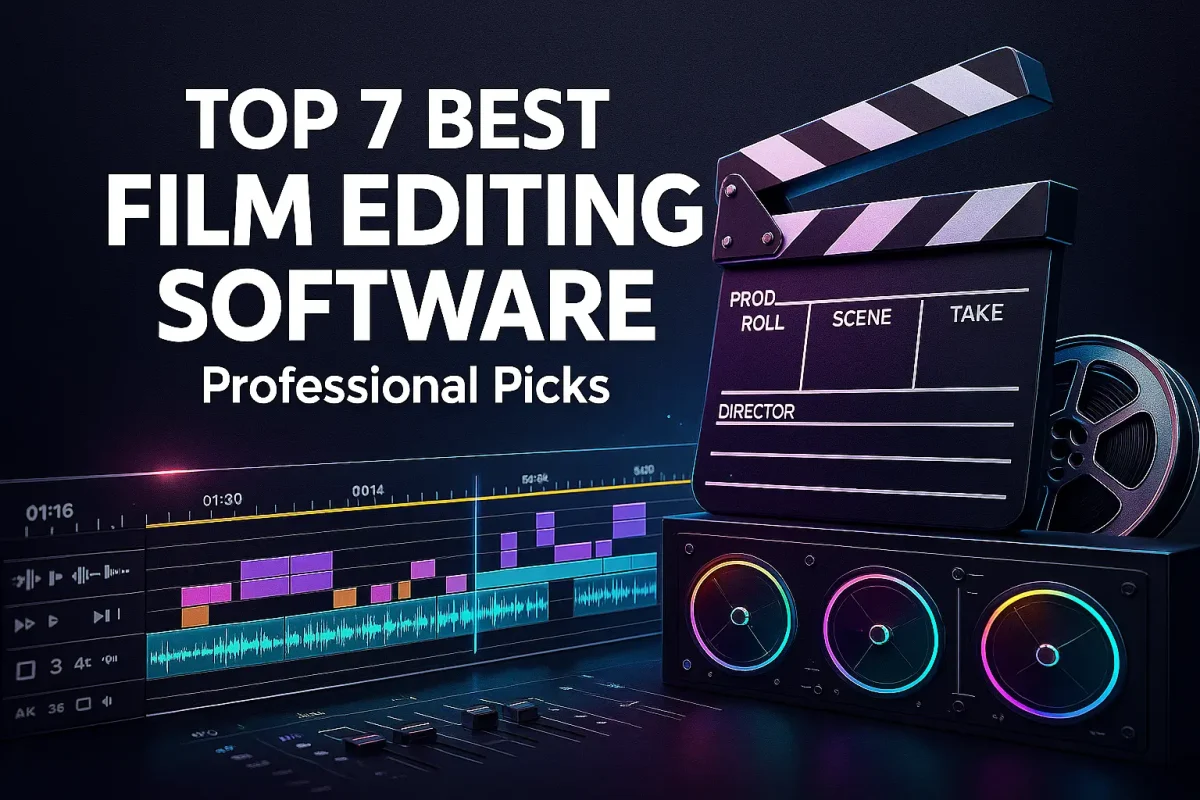Modern editors access professional capabilities on consumer and pro hardware. You evaluate options by timeline performance, color management, audio tools, format support, collaboration, and export reliability. Several platforms provide free tiers; others provide one-time or subscription licenses.
Quick Takeaways
- Maximum capability: DaVinci Resolve (robust free tier) and Adobe Premiere Pro.
- Mac performance: Final Cut Pro optimizes for Apple silicon.
- Beginner value: Filmora and CapCut enable fast starts.
- Long-form collaboration: Avid Media Composer remains a standard.
Selection Criteria
When you compare tools, consider:
- Workflow integration: round-trips to motion graphics, audio, and still design.
- Format coverage: from smartphone codecs to 8K RAW and HDR.
- Color science: grading tools, color management, and monitoring.
- Audio post: dialogue cleanup, mixing, and delivery stems.
- Collaboration: shared projects, bin locking, and handoff formats.
- Licensing: free tiers, subscriptions, or perpetual options.
- Hardware fit: CPU/GPU acceleration and media cache behavior.
1) Adobe Premiere Pro — Cross-App Workflow Backbone
Use case: If you work across editing, motion graphics, design, and audio, you benefit from the Adobe ecosystem.
Highlights
- Integrates with After Effects, Audition, and Photoshop via dynamic links.
- Supports multicam, proxies, and wide codec coverage from phones to 8K RAW.
- Provides Team Projects for cloud collaboration.
Notes for you - You streamline graphics and audio passes without leaving the NLE.
- You plan for subscription costs and ensure modern hardware for best performance.
2) DaVinci Resolve — Unified Edit, Color, Audio, VFX
Use case: If color quality and finishing matter most, you centralize in a single application.
Highlights
- Combines Edit, Color, Fairlight (audio), and Fusion (compositing).
- Free version offers professional features without watermarking.
- Studio ($295 one-time) adds collaboration, advanced denoise, and higher-than-UHD deliverables.
Notes for you - You perform conform, grade, mix, and light VFX without round-trips.
- You expect a learning curve and benefit from calibrated monitoring.
3) Apple Final Cut Pro — Speed on Apple Silicon
Use case: If you edit on macOS and prioritize throughput, you leverage Apple silicon optimization.
Highlights
- Magnetic Timeline accelerates assembly and prevents collisions.
- Smooth playback for 8K, HDR, 360°, and multicam projects.
- $299 one-time license with ongoing updates.
Notes for you - You gain export speed and low fan noise on portable Macs.
- You plan Mac-only environments; team features exist but differ from traditional bin locking.
4) Avid Media Composer — Long-Form and Team Reliability
Use case: If you manage complex series or feature workflows, you use Avid for media management and turnover.
Highlights
- Robust bins, metadata, ScriptSync, and version control.
- Reliable AAF/OMF handoffs to sound and VFX.
- Stable shared projects across multiple editors.
Notes for you - You align with facility standards and established broadcast pipelines.
- You allocate onboarding time for interface conventions.
5) Filmora — Accessible Entry Path
Use case: If you start editing or deliver straightforward projects, you value a simple interface.
Highlights
- Clean UI with AI tools such as auto beat-sync, speech-to-text, and noise removal.
- Annual plan options; free tier exports with watermark.
Notes for you - You complete shorts, reels, or educational projects quickly.
- You step up to advanced grading later if your pipeline expands.
6) CapCut — Fast Assembly with Smart Automation
Use case: If you create social-first or promo content and want rapid iteration, you adopt CapCut’s AI helpers.
Highlights
- Free desktop and mobile apps with auto-reframe, voice isolation, and beat detection.
- Cross-device syncing for on-set rough cuts and at-home finishes.
- Handles 4K and basic multicam.
Notes for you - You assemble quickly and, when needed, finish color in another tool such as Resolve.
7) Vegas Pro — Responsive, Audio-Savvy Editing
Use case: If you cut music-driven or event projects and prefer keyboard-centric timelines, you optimize with Vegas.
Highlights
- Low-latency playback, tight audio tools, motion tracking, and 4K HDR.
- Subscription and perpetual options.
Notes for you - You benefit from a nimble timeline and direct audio control.
- You plan around a smaller ecosystem for templates and integrations.
Honorable Mentions
- iMovie (macOS, free): Efficient for basic cuts, reels, and iPhone workflows.
- Lightworks: Longstanding NLE with a focused UI; free tier with feature limits and low-cost Pro.
- Shotcut (open source): Cross-platform basics, broad format support, and community-driven updates.
How You Choose: Practical Path
- Define pipeline: If you need motion graphics and design round-trips, start with Premiere.
- Prioritize look: If grading quality leads, select Resolve.
- Match hardware: If you edit on a Mac laptop, Final Cut Pro maximizes performance.
- Scale teams: If you share long-form projects, Avid aligns with facility standards.
- Start fast: If you learn or deliver shorts, Filmora or CapCut accelerates results.
- Cut to music: If timing precision matters, evaluate Vegas Pro.
Conclusion
Each platform serves a distinct workflow. You gain speed and quality by aligning software with your hardware, collaboration model, and deliverables. Free or trial versions let you validate performance on your footage. When you pick the tool that fits your process, you edit efficiently and deliver consistent results.

